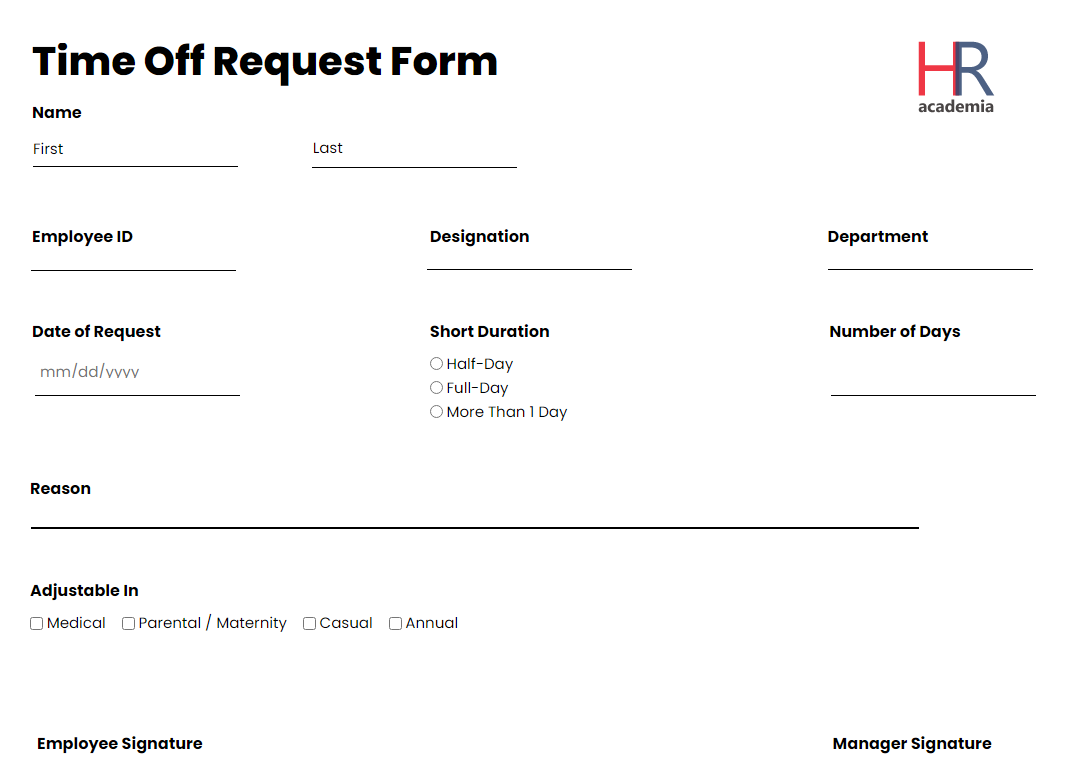Employee Time Off Request Form Templates
Time Off Request forms serve as a bridge between employees and employers, facilitating the management of leave time in the workplace. In today’s dynamic and flexible work environments, achieving a healthy work-life balance is very important, and these forms help ensure that employees can effectively request time away from work while enabling employers to maintain operational efficiency. In this guide, we will explore the purpose and types of time off request forms. Additionally, we will also go through the steps of creating effective time off request forms.
Understanding The Employee Time Off Request Form
At some point in their career, every employee has to take time off from work due to either vacation, medical leave, or personal circumstances. To take a leave, employees must communicate to their employer their intentions beforehand, and that’s when time off request forms come into action.
What is a Time Off Request Form?
A time off request form is a document that formally records when an employee asks for a leave. It includes all the details of the request, such as the reason for the absence and the dates the employee will be gone. It also includes a spot to indicate if their supervisor approved or denied the request. These forms keep you organized if you only allow a certain number of employees off at one time.
Types of Paid Time Off
When talking about leaves, our minds immediately go to vacation and sick days. However, there is more to it when it comes to paid time off; some of these leaves are legally mandated to be available and others are offered as perks. There are multiple types of paid time off, and some of them include:
Vacation Days
Vacation pay is paid time off that employers give employees to travel, spend time with family or friends, or take a break from work. The number of vacation days that businesses offer could vary; however, a typical vacation policy should explain rules relating to when and how employees can take off for vacation.
Sick Leave
Paid sick leave is time off that an employee can use when they are sick or injured. Offering sick pay can reduce the chances of illnesses spreading to your other employees by encouraging sick employees to stay home. Many countries are legally obligated to offer sick pay to their employees, therefore, employers must check with your region’s laws as well.
Personal Time
Employees can use personal time off to handle things like doctor’s appointments, car checkups, attending events, and anything else that does not fall under sick or vacation time. Personal time does not have to be used for anything specific and employees can use this time without having to use their vacation days.
Holidays
Holidays are paid time off from work happening during public holidays, which mainly include Christmas, Thanksgiving, New Year’s, etc. These leaves are usually regulated by the state and the employer has to comply with it. However, these leaves can vary between part-time employees and full-timers.
Bereavement
Paid bereavement leave is the time off employees receive when a family member or friend passes away. Employees can use bereavement to cope with their loss, make arrangements, and attend funeral services. Some organizations give different amounts of bereavement time off, depending on the employee’s relationship to the deceased. Employers can also require employees to provide proof of the loss of death, such as an obituary or funeral program.
Parental Leave
Paid parental leave is time away from work that employees can use for maternity leave, paternity leave, or adoption. Under federal law, employers might or might not be required to offer unpaid parental leave, however, it also depends on the business size of the organization.
Jury Duty
If an employee gets called to serve on a jury, employers are obligated to offer jury duty pay for the time they are away. A federal, state, or local court will send the employee written notice summoning them for jury duty. Employers can ask employees to show their jury duty summons letter before offering them paid jury duty.
Voting Time
Paid voting time is time off employees can use to vote in presidential and local elections. Generally, paid voting time is limited, as employees only need a few hours to vote.
Military Leave
Employers should also provide paid military leave to employees for active duty, active-duty training, or inactive duty training. All employers must follow USERRA (Uniformed Services Employment and Reemployment Rights Act). USERRA requires employers to offer an unpaid leave of absence to employees in the military for up to five cumulative years.
How to Create a Simple Time Off Request Form
Since every employee takes time off from work at some point, every organization should provide the right procedure to make this process easier and hassle-free. In this regard, a time off request form is very important to implement a formalized structure. Here are some steps that you can follow to create a time off request form:
Identify the Necessary Information
You must begin by deciding what information you need from employees to approve or deny time off. Usually, this includes the dates requested and the reason for time off. Some workplaces, like schools, may require finding a substitute teacher or providing lesson plans. Therefore, you must include those requirements on the form if needed for your organization.
Provide Instructions
Determine a clear set of steps for the employee to follow to accurately complete and submit the form. This includes how far in advance they should submit their form, whom to give it to, and how they will receive notice of approval or denial.
Create a Fillable Form
Now that you have a list of the information you need from employees and the process through which they will request leave, create a fillable form. A fillable form can be completed online or printed and filled in by hand. The following items should typically be present on the form:
- Date of Request: The date on which the employee is requesting the leave.
- Name and Title: The time off request form should include the employee’s full name and contact information. It should also include their title, department, or other information identifying their role in the organization.
- Supervisor Name: The name of the employee’s boss or supervisor should also be present on the form. This helps establish who will decide whether the employee should receive a leave or not.
- Requested Time Off: The employee should also state the days or hours they need off. If they require multiple days off from work, they must include their absence’s start and end dates. If they require only a few hours off, then the date and the number of hours can be included as per the need.
- Reason for Request: Employers must include a section where employees should state their reason for taking time off. The reason can be anything, from vacation to medical leave.
- Employee Signature: There should also be a space where employees can sign and mention the date on the time off request form. Their signature formalizes their request and is critical to an effective time off request form.
- Manager Approval Section: The time off form must include a section for the manager to approve it. This section should be left blank by the employee and filled by the employer or any other concerned person.
Communicate the Policy to Employees
Ensure all employees are aware of the process for requesting time off. Add the policy and a copy of the time off request form template to the employee handbook.
Post the Form
Provide copies of the time off request form for employees to use. This could be online through a portal, a shared local office drive, or even hard copies. Determine which method of sharing works best for your organization and employees.
Sample Template for Employee Time Off Request Forms
You can use this time off request form template to use as a guide for creating one for your organization:

Final Tips to Manage Paid Time Off Requests
Establish Time Frames: Create a minimum amount of notification employees need to provide for paid time off requests to allow you to make arrangements for their absence. For emergencies, indicate how soon employees need to notify you if they cannot be at work.
Address Overlapping Requests: To avoid having too many employees gone at once, establish guidelines to determine who can take time off on the requested dates when overlapping requests happen.
Plan for Office Productivity: Set up a temporary hierarchical structure for your employees when team leaders or those in vital roles are gone by delegating tasks and additional responsibilities to other team members.
Set Time Off Restrictions: Identify times when employees are not allowed to take off unless there is a death, sudden illness, or other emergency.
